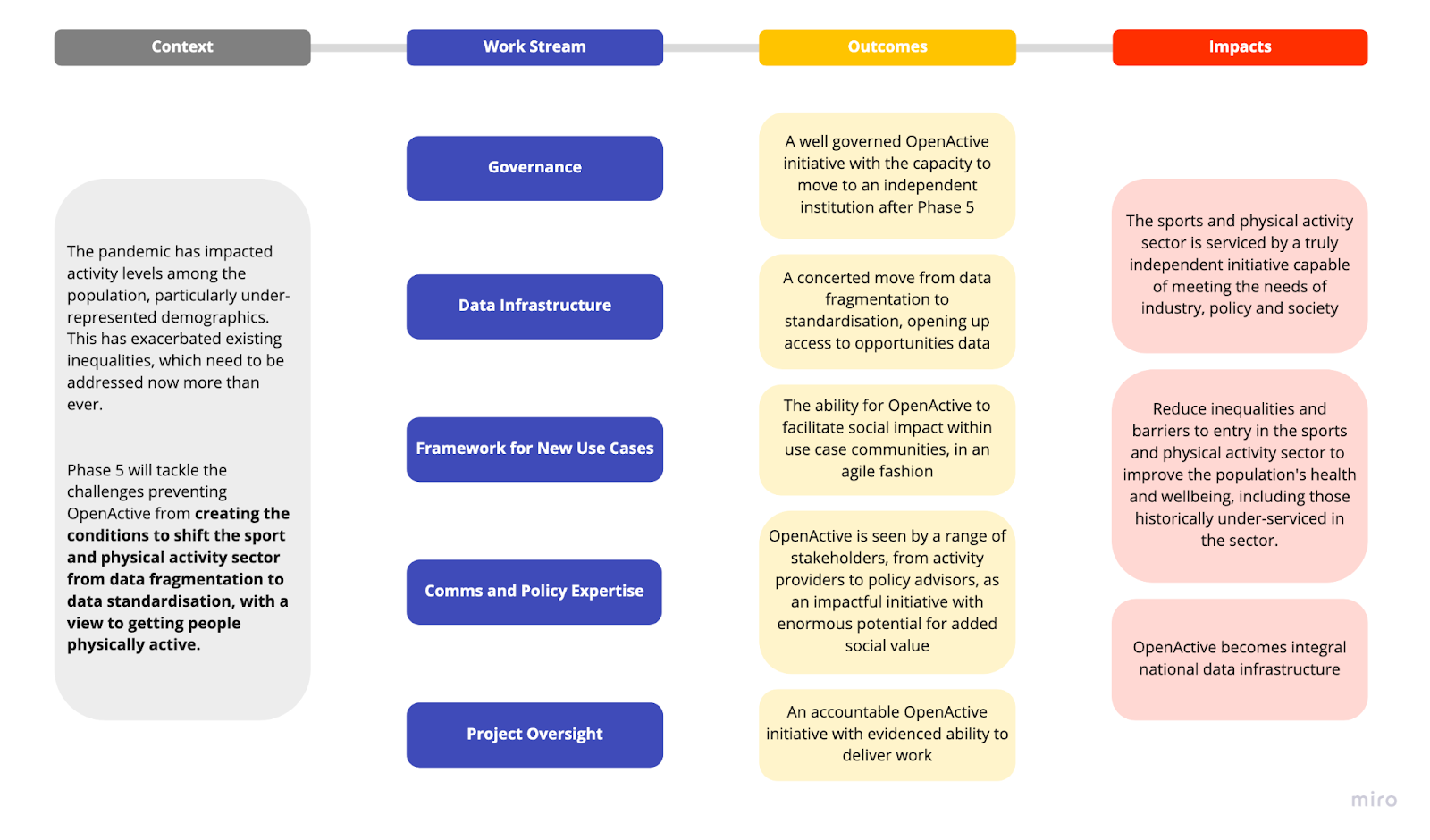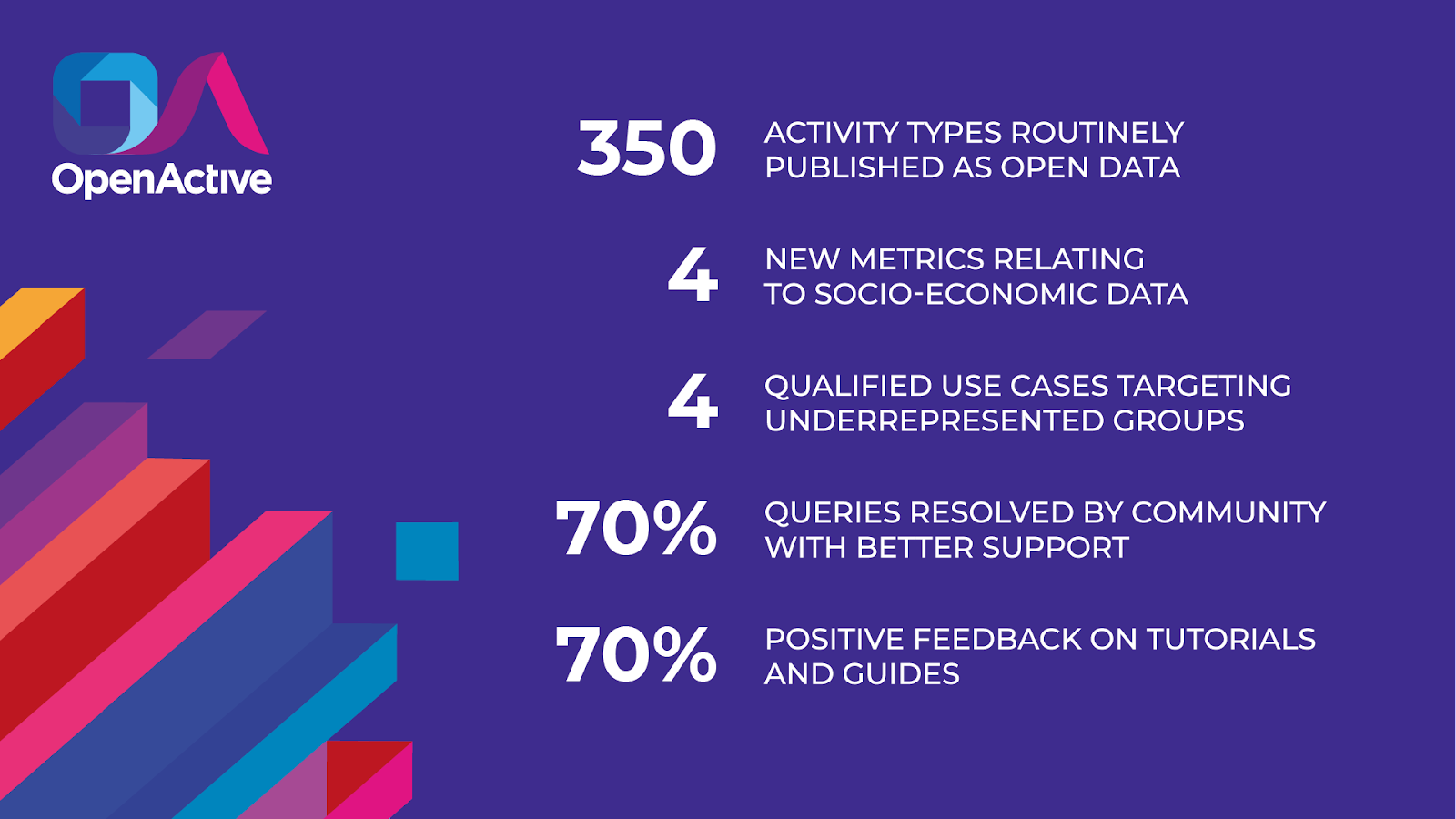
The Open Data Institute (ODI) and Sport England have embarked on the next stage of OpenActive, a major open data project to tackle inactivity. This phase of the initiative will focus more on enabling organisations to use OpenActive’s data infrastructure and making the initiative self-sustaining – something that Monitoring, Evaluation and Learning (MEL) will play a critical role in. This is a summary of OpenActive’s approach to MEL – for more detail, read OpenActive's blogpost: Improving impact: Our approach to monitoring, evaluation and learning
Post-pandemic physical inactivity
The Covid-19 pandemic had an unprecedented impact on people’s ability to get active.
There is overwhelming evidence for the life benefits of being active – from childhood through to old age. These benefits deliver billions of pounds of value to our healthcare systems, society and economy every year.
However, since the pandemic restrictions were lifted, Sport England’s Active Lives Adult Survey November 2020-21 Report found that 17.6m or (38.7%) of adults in England are not getting the benefits of being regularly active – there are still 0.6m (1.9%) fewer active adults (those that do at least 150 minutes of activity a week) and 1.3m (2.6%) more inactive adults (those that do less than 30 minutes of activity a week).
OpenActive is a major open data initiative that enables the publishing of standardised open data on physical activities and promotes innovation to make it easier to find and book these opportunities online. A lack of high-quality open data in the sport and physical activity sector is a barrier to getting people active – OpenActive has made significant progress over the past five years to tackle this.
Post-pandemic there has been a disproportionate impact on activity levels among marginalised demographics such as children and young people, older people, women, disabled people and culturally diverse communities, exacerbating existing inequalities. Addressing this inequality is needed now more than ever, and this is where we believe making it easier for people to find opportunities, with the use of OpenActive, can help.
Delivering impact by design
This next phase of OpenActive will look to address some of the issues outlined in Sport England’s ‘Uniting the Movement’ strategy – like designing data infrastructure to support the specific needs of people who are less likely to be active, encouraging innovation in the sector, and creating a more inclusive sport and physical activity landscape. It will also explore the connection to key policy challenges around health and wellbeing, data and digital strategies and the economy.
As we move to the next phase of OpenActive, it’s important to now focus on the long-term strategic direction and governance structure of the initiative. To do this, OpenActive is embedding Monitoring, Evaluation and Learning as a core tenet of its delivery approach and operational structure. This will help to ensure the longer-term sustainability of the initiative.
The approach to MEL is not a static one – there will be opportunities for updates over time, through regular reflection and a commitment to continuous improvement and the sharing of insights.
Logic model
Logic models provide the structure to help ensure the inputs (activities/ work completed) to the outcomes and impacts desired. The OpenActive team has developed a logic model (simplified version below) for this phase of the initiative that outlines the impact that it expects OpenActive to achieve.

The logic model is a feature of impact by design – it identifies the activities that we need to focus on in order to realise the intended social impact:
- The sports and physical activity sector is serviced by a truly independent initiative capable of meeting needs of industry, policy, and society
- Reduce inequalities and barriers to entry in the sports and physical activity sector to improve the population's health and wellbeing including those who are historically underserved
- OpenActive becomes integral to national data infrastructure
To see a more detailed version of the OpenActive logic model, visit the OpenActive blogpost.
KPIs
Key Performance Indicators (KPIs) define the outputs and outcomes that are expected to lead to the main (social) impact of the project. They are defined in the logic model at the beginning of the project and offer us a way to ensure that OpenActive remains on track.
In total, 40 KPIs will be used to track and evaluate OpenActive’s progress, which we are making public as part of our open working commitment.

You can find more of the KPIs in the OpenActive blogpost.
By giving more focus through MEL to the long-term strategic direction and governance structure of the initiative, OpenActive can expand and improve its social impact.
Want to find out more?
You can find more information on OpenActive’s approach to MEL in the OpenActive blogpost on improving impact, alongside a simple version of the logic model.
- Read the OpenActive blogpost on improving the impact of OpenActive
- Read the Sport England blogpost on this phase of OpenActive
- Read the ODI blogpost on this phase of OpenActive
Or if you’d like to speak to one of the team, contact: [email protected]